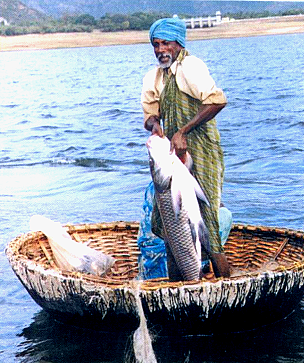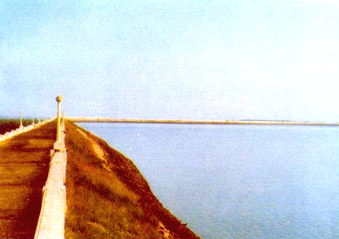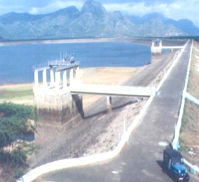Reservoirs
Small reservoirs
Culture based Fisheries of small reservoirs
The man made water bodies created by obstructing the surface flow or erecting a dam of any description, on a river, stream or any water course called reservoirs. The small reservoirs have an area of <1000 ha. Culture based fisheries technology was particularly important for open waters like small reservoirs. Fish yield of these reservoirs, where the management is on the basis of culture-based fisheries is dependent on a number of parameters, such as growth rate, natural mortality and fishing mortality. Therefore, stocking density, size at stocking, size at harvesting, rate of fishing mortality, and harvesting schedule hold the key for obtaining the optimum yield. A close scrutiny of the fishery management followed indicates that these vital aspects of management are also very crucial.
Potential transferable area
The small reservoirs are a common feature of rural landscape in most of the states of India. Primarily, these states are Madhya Pradesh, Andhra Pradesh, Karnataka and Tamil Nadu. The small reservoirs constitute the prime inland fishery resource of India by virtue of their vast area (1.5 million ha) and huge production potential (150 kg ha-1 year-1). |
 |
Production guidelines/ user guidelines including input requirements
Assessment of yield potential
Several methods are in vogue to assess the fishery potential of small reservoirs, based on area, depth, catchment area and the chemical characters of soil and water. Morpho-edaphic index (MEI) was evolved in an attempt to combine the morphometric as well as chemical parameters. A Morpho-edaphic index may be computed as MEI= Specific conductivity (μmhos cm-1) per unit mean depth (m). For indian reservoirs it has been used to estimate fish yield potential as:
C= 3.984 MEI0.6374
Enhancement
Fisheries enhancement can be achieved through human interventions in the aquatic ecosystems with a view to increasing their productivity. The common modes of enhancements, which are relevant to small reservoirs in India, are stock enhancement (increasing the stock), species enhancement (inducting new species to broaden the catch structure), and environmental enhancement (enriching the water quality through artificial eutrophication). |
Stocking rate
Recently, based on the National Consultation on Reservoir Fisheries, the Government of India has adopted the following formula of Welcomme, 1976 to calculate the stocking rate for small reservoirs.
S= q.P e-z(tc-to)
W
|
 |
S - number of fish to be stocked (in number/ha)
P - natural annual potential yield of the water body
Q - the proportion of the yield that can come from the species in question
W - mean weight at capture
tc - age at capture
to - age at stocking
-z - total mortality rate
e - constant (2.7175)
P can be estimated through MEI method (mentioned above) and the range of mortality rates can be found out from the estimated survival rate. The calculation of stocking rates using the formula given above, when P= 200 kg/ha, q=1, w=0.5 kg and tc-t0 is 1. |
Advantage over similar technologies
In contrary to aqua cultural technologies, on one hand the technology involves very less capital and environment cost and on the other being a community –based development process, it has direct bearing on rural populace and the benefits of increased yield may be equitably distributed among large number of involved people/fishers.
Risk involvement including bio-safety
There is no risk involved including bio-safety as the technology involves only stocking of fish seed and no chemical application. The fish depend on the natural food viz. plankton and benthic organisms for their feed. Therefore, the technology improves the water quality of reservoir water.
The technology has no adverse impact on the aquatic environment, rather the fish stock eat up the plankton and benthic population and help in improving the water quality. |

Impact on environment |
Potential users
The fishers, state department personnel, NGOs, etc. involved in fisheries of small reservoirs in above mentioned states. |
Source:
Central Inland Fisheries Research Institute (ICAR)
Barrackpore
Kolkata -700 120,
West Bengal. |

